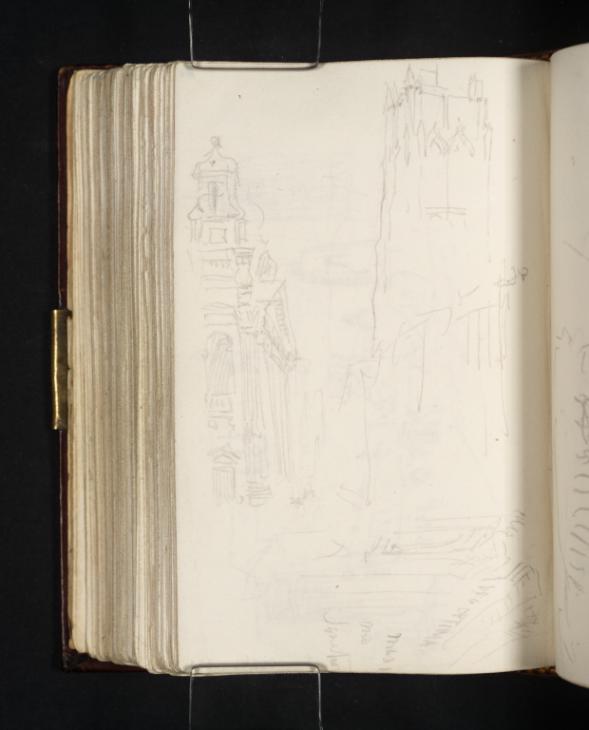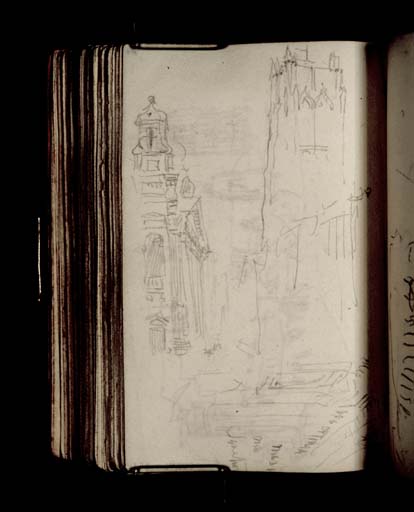Joseph Mallord William Turner The Belfry and Saint-Eloi Church, Dunkirk 1824
Image 1 of 2
Joseph Mallord William Turner,
The Belfry and Saint-Eloi Church, Dunkirk
1824
Joseph Mallord William Turner 1775–1851
Folio 190 Verso:
The Belfry and Saint-Eloi Church, Dunkirk 1824
D19919
Turner Bequest CCXVI 184 a
Turner Bequest CCXVI 184 a
Pencil on white wove paper, 118 x 78 mm
Inscribed in pencil by Turner ‘[?Rex] Optima’ | ‘Mas[...] [...] [?Sanctum]
Inscribed in pencil by Turner ‘[?Rex] Optima’ | ‘Mas[...] [...] [?Sanctum]
Accepted by the nation as part of the Turner Bequest 1856
References
1909
A.J. Finberg, A Complete Inventory of the Drawings of the Turner Bequest, London 1909, vol.II, p.677, as ‘Gothic Tower, with Renaissance Building’.
This previously unidentified sketch, catalogued by Finberg as ‘Gothic Tower, with Renaissance building’, can now be identified as showing a street in the port city of Dunkirk, France. Standing on the present day Rue Clemenceau, Turner pictures the medieval Belfry at right. The ‘renaissance’ building at left is actually the old façade of Saint-Eloi Church, constructed in 1785 to the designs of the architect Victor Louis (1731–1800).1 The ‘Corinthian portico’, as it was referred to by contemporary travel writers, stood for over a hundred years, but was demolished in 1882 owing to the condition of the time-worn and crumbling stonework.2 The façade was rebuilt in the Gothic Revival style in 1887.3
The old façade recorded here by Turner displays the free and sculptural use of classical orders which characterise Baroque architecture. There is an imposing pediment for an entrance, windows embellished with elaborate moulding, and a cupola topped with an onion dome crowning the whole. The façade was described by travel writer John Murray as ‘a handsome but most incongruous frontispiece to a Gothic building’: an inharmonious juxtaposition rather than a melding of architectural styles.4 Indeed most of Saint-Éloi dates to the second half of the fifteenth century, and initially incorporated the Belfry before a fire destroyed the original church. The bell tower remained isolated and was never reattached.
At the bottom of the page Turner has drawn a detail of the front of the Baroque façade, with its entablature and ‘ten Corinthian columns, in imitation of that of the Pantheon at Rome’.5 The artist has inscribed: ‘[?Rex] Optima’ on the entablature and below the largely indecipherable ‘Mas[...] [...] [?Sanctum]’.
For other drawings of Dunkirk see Tate D19911, D19915–D19918, D19942; Turner Bequest CCXVI 180, 182–184, 196.
Alice Rylance-Watson
June 2014
‘L’église Saint Eloi’, Ville Dunkerque, accessed 2 October 2014, http://www.ville-dunkerque.fr/decouvrir-dunkerque/histoire-de-la-ville/leglise-saint-eloi
‘L’église Saint Eloi’, Ville Dunkerque, accessed 2 October 2014, http://www.ville-dunkerque.fr/decouvrir-dunkerque/histoire-de-la-ville/leglise-saint-eloi
How to cite
Alice Rylance-Watson, ‘The Belfry and Saint-Eloi Church, Dunkirk 1824 by Joseph Mallord William Turner’, catalogue entry, June 2014, in David Blayney Brown (ed.), J.M.W. Turner: Sketchbooks, Drawings and Watercolours, Tate Research Publication, April 2015, https://www


